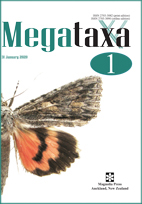Abstract
Taxonomy is the business of describing and naming organismal diversity. What that means exactly must shift as our conceptual framework shifts (as it did during the time of Darwin) and as what we are able to see shifts as a result of technological assists. We are at a moment of profound conceptual and technological change. Here I give some personal thoughts on three top questions in taxonomy. Are traditional naming conventions compatible with massive cryptic genetic discontinuity? Can we agree on what we are delimiting and naming? Can we excite public interest without typology?
References
Bolton, B. (2020) An online catalog of the ants of the world. Available from http://antcat.org. (accessed 3 January 2020).
Butcher, B.A., Smith, M.A., Sharkey, M.J. & Quicke, D.L. (2012) A turbo-taxonomic study of Thai Aleiodes (Aleiodes) and Aleiodes (Arcaleiodes) (Hymenoptera: Braconidae: Rogadinae) based largely on COI barcoded specimens, with rapid descriptions of 179 new species. Zootaxa, 3457, 1–232.
https://doi.org/10.11646/zootaxa.3457.1.1
Colosimo, P.F., Hosemann, K.E., Balabhadra, S., Villarreal, G., Dickson, M., Grimwood, J., Schmutz, J., Myers, R.M., Schluter, D. & Kingsley, D.M. (2005) Widespread parallel evolution in sticklebacks by repeated fixation of ectodysplasin alleles. Science, 307, 1928–1933.
https://doi.org/10.1126/science.1107239
Donoghue, M.J. & Alverson, W.S. (2000) A new age of discovery. Annals of the Missouri Botanical Garden, 87, 110–126.
https://doi.org/10.2307/2666212
Edelman, N.B., Frandsen, P.B., Miyagi, M., Clavijo, B., Davey, J., Dikow, R.B., García-Accinelli, G., Van Belleghem, S.M., Patterson, N., Neafsey, D.E., Challis, R., Kumar, S., Moreira, G.R.P., Salazar, C., Chouteau, M., Counterman, B.A., Papa, R., Blaxter, M., Reed, R.D., Dasmahapatra, K.K., Kronforst, M., Joron, M., Jiggins, C.D., McMillan, W.O., Di Palma, F., Blumberg, A.J., Wakeley, J., Jaffe, D. & Mallet, J. (2019) Genomic architecture and introgression shape a butterfly radiation. Science, 366, 594–599.
https://doi.org/10.1126/science.aaw2090
Funk, W.C., Caminer, M. & Ron, S.R. (2012) High levels of cryptic species diversity uncovered in Amazonian frogs. Proceedings of the Royal Society B: Biological Sciences, 279, 1806–1814.
https://doi.org/10.1098/rspb.2011.1653
Hebert, P.D., Penton, E. H., Burns, J.M., Janzen, D.H. & Hallwachs, W. (2004) Ten species in one: DNA barcoding reveals cryptic species in the neotropical skipper butterfly Astraptes fulgerator. Proceedings of the National Academy of Sciences of the United States of America, 101, 14812–14817.
https://doi.org/10.1073/pnas.0406166101
Hillis, D.M. (1988) Systematics of the Rana pipiens complex: puzzle and paradigm. Annual Review of Ecology and Systematics, 19, 39–63.
https://doi.org/10.1146/annurev.es.19.110188.000351
Linnaeus, C. (1758) Systema naturae per regna tria naturae, secundum classes, ordines, genera, species, cum characteribus, differentiis, synonymis, locis. Tomus I. Editio decima, reformata. Holmiae [= Stockholm]: L. Salvii, 824 pp.
Mallet, J., Besansky, N. & Hahn, M.H. (2016) How reticulated are species? Bioessays, 38, 140–149.
https://doi.org/10.1002/bies.201500149
O’Hara, R.J. (1993) Systematic generalization, historical fate, and the species problem. Systematic Biology, 42, 231–246.
https://doi.org/10.1093/sysbio/42.3.231
Pollard, D.A., Iyer, V.N., Moses, A.M. & Eisen, M.B. (2006) Widespread discordance of gene trees with species tree in Drosophila: evidence for incomplete lineage sorting. PLOS Genetics, 2, e173.
https://doi.org/10.1371/journal.pgen.0020173
Schluter, D. (2009) Evidence for ecological speciation and its alternative. Science, 323, 737–741.
https://doi.org/10.1126/science.1160006
Wilson, E.O. (2004) Taxonomy as a fundamental discipline. Philosophical Transactions of the Royal Society of London. Series B: Biological Sciences, 359, 739–739.
https://doi.org/10.1098/rstb.2003.1440


